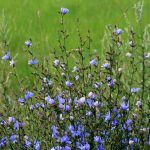Lolium perenne, commonly known as perennial ryegrass, is a widely used cool-season grass valued for its durability, lush green appearance, and fast growth. Native to Europe, Asia, and North Africa, it has become popular worldwide as a turfgrass for lawns, sports fields, and pastures due to its resilience and relatively low maintenance.
Characteristics
- Appearance: Perennial ryegrass has fine, glossy green leaves that are smooth and grow upright. Its leaves are narrow, giving it a dense and vibrant appearance.
- Growth: It has a fast germination rate and establishes quickly, making it an excellent choice for areas where rapid growth is desired. It can tolerate moderate foot traffic and can withstand some drought but requires regular moisture for optimal growth.
- Climate: As a cool-season grass, perennial ryegrass thrives in mild to cool climates and performs best in the spring and fall, showing less tolerance to extreme summer heat.
- Lifespan: Although it’s termed “perennial,” in very hot climates, it may act more like an annual if it cannot tolerate the summer heat.
Uses
- Turfgrass: Commonly used in residential lawns, parks, and sports fields for its dense, attractive coverage.
- Agricultural: Perennial ryegrass is also a valuable forage grass in livestock production, as it provides nutritious grazing material for animals.
- Erosion Control: Its extensive root system helps stabilize the soil, making it useful for erosion control on slopes and other vulnerable areas.
Maintenance
Perennial ryegrass requires regular mowing, watering, and fertilizing to maintain its vibrant green appearance. It also benefits from periodic aeration to prevent soil compaction, especially in high-traffic areas. Due to its rapid growth, it may need more frequent mowing than other grass types.
Ecological Benefits
Its dense growth habit can help suppress weeds, reducing the need for herbicides. Additionally, it provides excellent soil structure and has moderate tolerance to drought, which aids in water conservation in landscaping.
Challenges
- Heat Sensitivity: In regions with extreme summer temperatures, perennial ryegrass can struggle, leading to thinning or browning.
- Disease Susceptibility: It can be prone to diseases like rust, brown patch, and pythium blight, particularly in humid conditions.
- Water Requirements: While it can tolerate some drought, it requires consistent moisture, especially in dry periods.
In all, Lolium perenne is a versatile and resilient grass species, ideal for temperate climates where its beauty, quick establishment, and utility are highly valued.


Leave a Reply